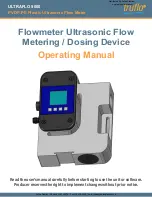
Potential equalization
The Magphant should be connected to ground via the ground terminal at the housing
to ensure complete electromagnetic compatibility.
Note!
Take care that the ground cable is kept as short as possible.
3.3 Commissioning
Before switching on the measuring system, the following checks should be carried
out:
•
Does the directional arrow on the Magphant agree with the actual flow direction,
i.e. do the two PG 16 cable glands lie at 90° to the direction of flow?
•
Check the electrical connections and terminal assignments as shown on Page 13.
•
Check that the local power supply agrees with the information stated on the name-
plate.
The following procedure should now be carried out:
1. Set miniature switch 1 (test mode) to the "normal" position (see Page 17).
2. Set the miniature switches 2 to 4 for
– time constant / relay latch time
– relay function
– min. / max. fail-safe
as appropriate.
3. After switching on the power supply, the outputs are deactivated for 5s (relay de-
energised and current output remains at 0 mA). Both LEDs flash during this proce-
dure.
4. Set the full-scale value. This can be done in two ways:
Full-scale value with actual flow (local calibration)
– Take into account general flowrates anticipated.
– Turn the full-scale potentiometer until the green LED lights up (see Page 16).
Setting the full-scale value without actual flow
– Set the full-scale potentiometer at the mean flow rate anticipated.
5. Use the limit switch to set the relay switchpoint in % of the preset full-scale as
described in Point 4.
Note!
A detailed description of the display and operating elements is given on Page 15/16.
4 mm
2
Cu wire
b
a025
y
0
3
Fig. 13:
Magphant potential equalization
3. Electrical Connection
Magphant
14
Hauser
Summary of Contents for magphant
Page 4: ...Magphant 4 Endress Hauser ...
Page 23: ......










































